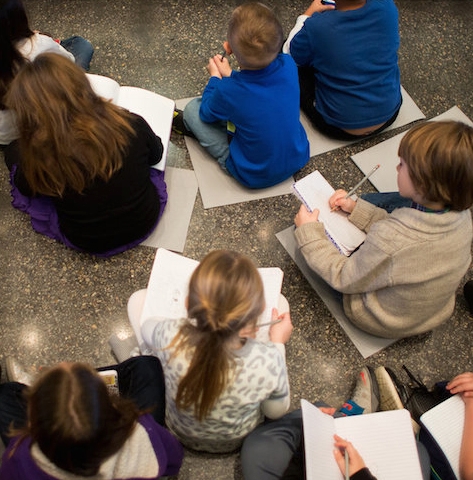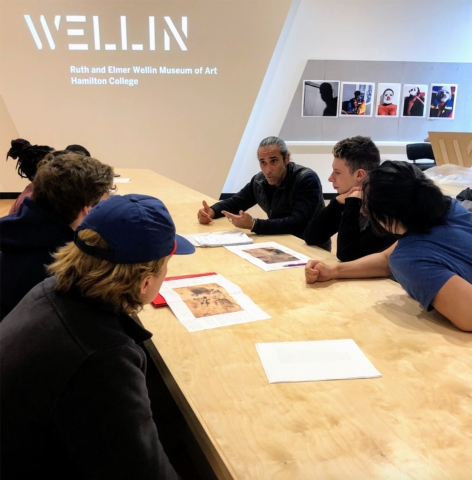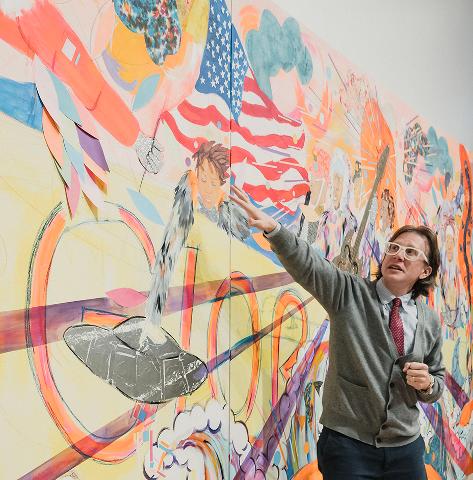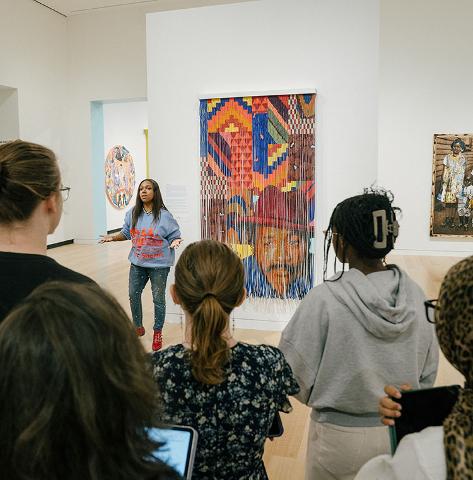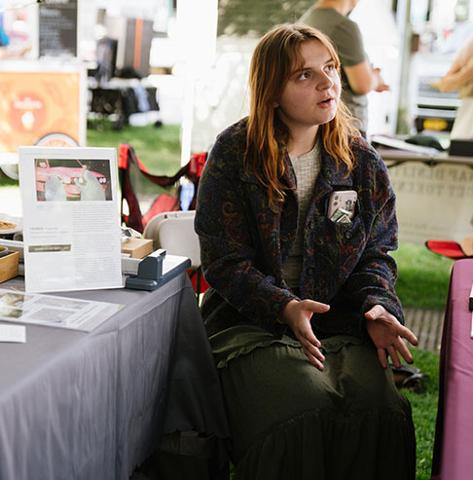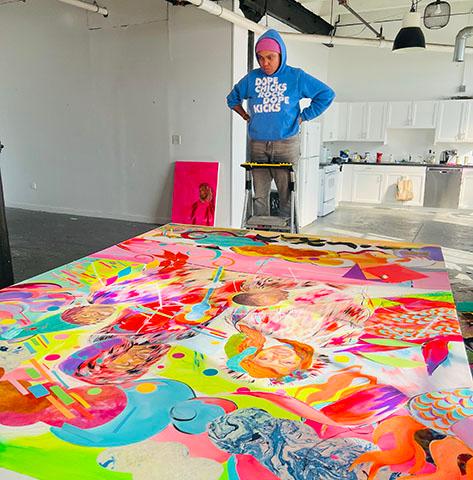Julia Jacquette. "A Constant Stream," 2014. Oil on linen, 48 x 60 in. Collection of the artist, New York. © 2016 Julia Jacquette. Image courtesy of the artist. Photograph by Shinji Otani.
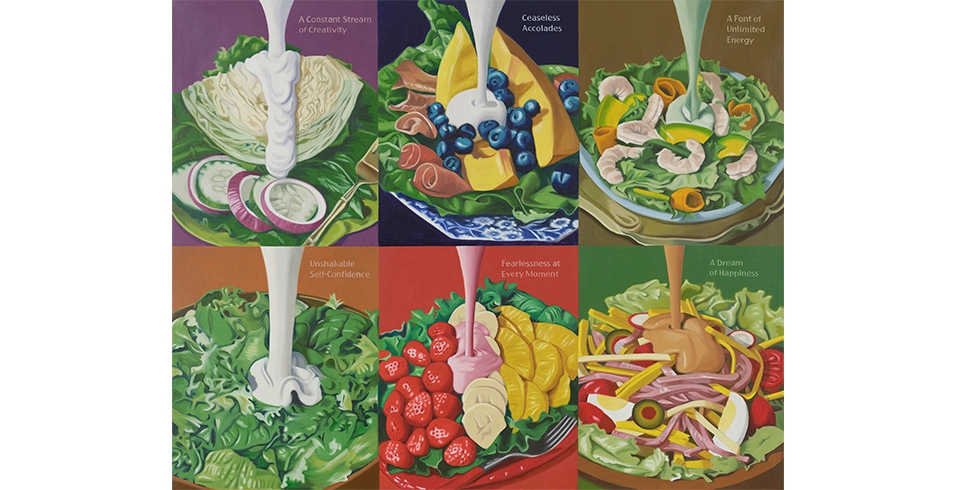
Food is more often than not at the center of Julia Jacquette’s paintings. Her canvases are full of cakes, candy bars, pies, and cookies, all lovingly plated to represent the perfect American sweet. The foods are a way in, drawing the viewers’ attention to all that these types of images of food represent, particularly this idea of the perfect American domestic life. She pulls the imagery from a variety of places, and often substitutes food for paintings of hair or liquor or other objects of desire. But these varying forms always lead to biting critiques. And the way she paints them, so lush and gleaming, fills them with a seduction as powerful as the ads and glossy images she’s sourcing.
Author Joan Wickersham once wrote of Jacquette’s work, “What woman hasn’t found herself seduced by the mass media’s fictional depiction of the perfect wedding, the perfect family, the perfect hair, or the perfect apartment? I can’t help but be attracted, as well as repelled, by the glossy, luscious consumerism Jacquette portrays. I envy it, and yet hate the way it has warped our society’s image of what it means to be a woman.”
A survey of Jacquette’s paintings, food or otherwise, are on view at the Wellin Museum of Art at Hamilton College in Clinton, New York through July 2. The exhibition will then travel to the Visual Arts Center of New Jersey in the autumn of 2017. We spoke with Jacquette via email prior to the opening of the exhibition at the Wellin on February 18th.
You have been painting food for some time now. I read that they were based on images from old cookbooks. What attracts you to these images in old cookbooks?
Much of my source material is old cookbooks, but also contemporary food magazines as well. I think what attracts me is the whole look of the food styling in these photos. It's almost like they're little movie sets: hyperlit, subject matter styled to perfection, shown in Technicolor colors.
You often add some affectionate phrase to them. Where do these phrases come from?
I write the text for my paintings. Adding the text under (or nearby) the images is my way of bringing to the surface things I think we are all thinking about. In the early 1990s when I first started making this work, the text referred to desire—sexual longing—but also a kind of general feeling of constant wanting. The most recent paintings have text that is about longing, but now it's mixed with a kind of anxiety and self-doubt.
What, to you, is the relationship between food and love?
For many of us, the relationship between food and love is a strong one in our lives, and can be a complicated one. I first started using food imagery in my work because it seemed like such a good visual metaphor for romantic desire, and also, images of food are just so arresting. As I made the paintings that featured images of food, I realized how many other topics and issues pictures of food brought up for myself (and I suspect, for viewers of the work): connections with one’s family, the feeling that food equals love, eating disorders, et cetera.
Sometimes you play with ideas of gender in food. For instance, a painting of four cakes, called “Four Men”; I feel like the gender of food is often undiscussed. How does this play into your work?
In “Four Men,” the cakes are labeled with men's names (where normally you'd see the name of the kind of cake it is). I was trying to make a work about strong romantic and sexual desire for men. I was thinking about thousands of years of art history in which male artists made images of women in order to possess/celebrate/idolize them. How could I do the same, but not just use the simple ploy of making literal images of men? Food seemed to offer so many visual and metaphorical possibilities.
But I agree, I feel the gender of food is an under discussed topic. The kind of food images I use (and I cull them from both contemporary and ‘vintage’ cookbooks and magazines) are a kind of highly styled food, that I think was and is targeted at women—food that looks like it is achieving a kind of domestic perfection.
And related topics that aren't necessarily discussed in my work, but I that I think about a lot are a) that although women are still doing most of the cooking in our society, the most celebrated ‘authors’ of our contemporary food world are men. And b) the recent, I think admirable, slow food movement hasn't quite acknowledged that in most households whomever is cooking the meals is also working full time, so no wonder prepared, or fast food, has to be the answer for many of us. Maybe that model of each individual household cooking for itself has to change.
Domesticity is a theme that comes up in your work—you've even named a 2008 show ‘Domestic Desires.’ What is the place of the cookbook in this context? How has your interest in domesticity evolved at all since you started thinking about it?
The very first impulse in using media images of food, home interiors, liquor, et cetera, was firstly just to wrangle with these images (that) I found so striking, yet I knew were created mostly just to get me to buy stuff. Cookbooks are incredibly useful, but also purvey a kind of ideal domestic life. In buying the book we're also trying to achieve that imagined, perfect existence. As an artist I'm incredibly fortunate that I can think about—and discuss with myself and my audience—all those issues through making my work. But also in the process of making artwork you ‘research’ your subject matter intentionally or not. Your thinking on that topic deepens and changes.
I was looking at images on your website, and I saw that you had made paper plates out of some of the food images for the Museum of Modern Art (MoMA). How did that come about, and can you tell me a little about that?
In the late-’90s, MoMA continued to run it's Project Series (giving many emerging artists their first museum show), although the museum no longer had a dedicated space for those exhibitions. So the then-senior curator of painting and drawing, Robert Storr, encouraged the assistant curators to think of alternative spaces within the museum where art could happen. A young assistant curator in the Department of Drawings and Prints, Judy Hecker, had the idea of having me design paper goods for MoMA’s Cafe Etc. (a temporary cafe (formerly) in the lower level of the museum). I think of those paper goods as an unlimited print edition that you can happen to eat off of. I really felt I’d made it when a friend said they saw one of those plates floating down the East River in a stream of debris.
While I was looking at the images, I noticed that one of the pictures was set in front of several of Andy Warhol’s “Campbell’s Soup Cans.” I thought that was really perfect, and I was wondering: Do you feel a connection in this series of paintings to the history of food as art?
Absolutely. I think of Andy Warhol as the ‘grandpa’ of my work. My artwork would not be possible without the ideas he put forth in his artwork, and the strides he made artistically and conceptually. When my first art dealer, Holly Solomon, first came to my studio to see my paintings, she asked me, ‘So what makes your work more than just a redo of Andy Warhol's work?’ I think, a completely legit question, by the way. My response was that my work is definitely indebted to his, but I am viewing these similar images and topics through the lens of feminism.
Is there a food that you find particularly satisfying to paint?
Food that has clear ‘architecture’ to it (most pastries and desserts have that kind of obvious structure), but also anything with a lot of glossy surface—it’s fun to be able to capture that kind of sparkling lighting.
Obviously, you have a lot of other work in the show that is not about food—10 years worth! What was the process of putting together a survey like in comparison to putting together an exhibition? Do you feel any sort of nostalgia when you're looking at something you made a decade ago?
I'm happy to say that the curator, Tracy Adler (who is the director of the Wellin Museum), made the choices of what artwork of mine went into the exhibition. I find it really difficult to make decisions when I have to curate my own work (funnily appropriate since, as Holly once said, an underlying theme of my work is the anxiety of choice). I trust Tracy’s decision-making completely—she's known me and my work for a long time.
The most satisfying feeling when looking at work I made a decade ago is actually, ‘Hey! I still like that!’
https://food.good.is/articles/julia-jacquette-food-paintings


